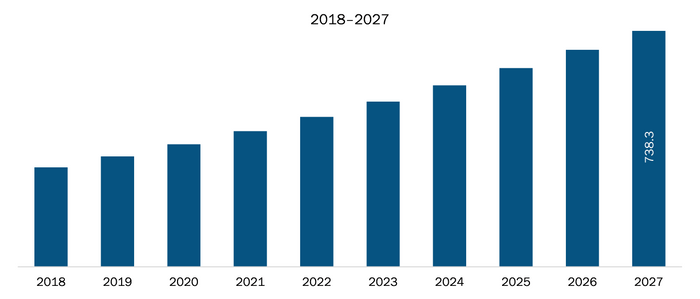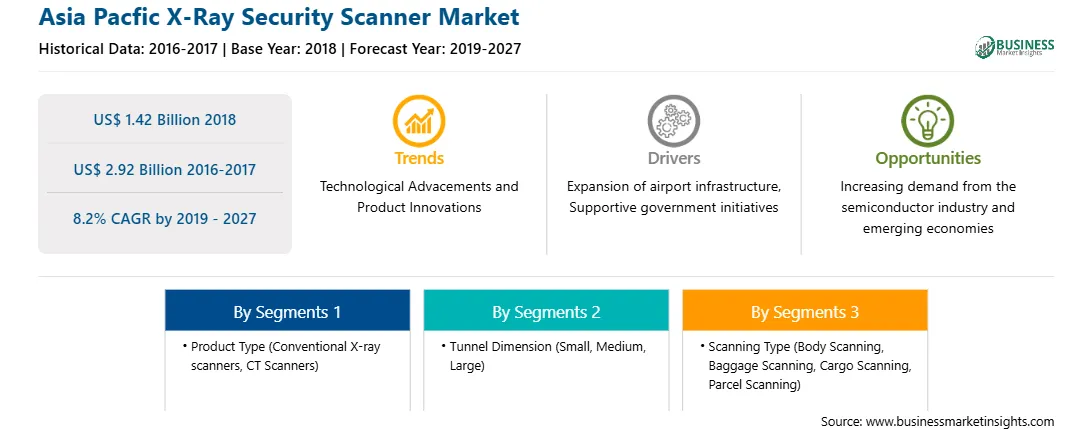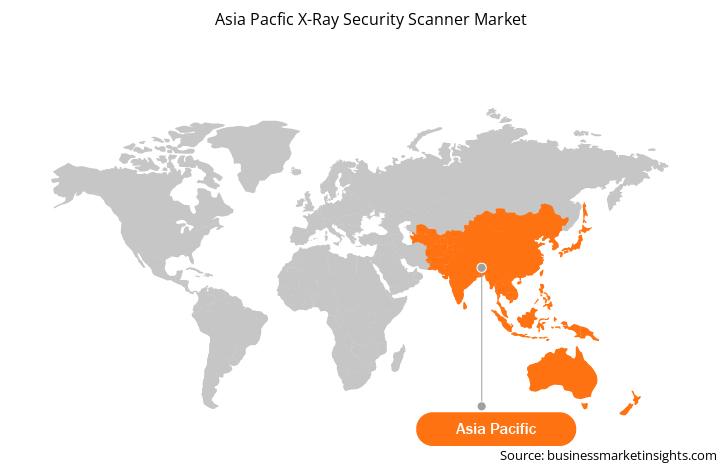X-ray security scanner market in Asia-Pacific is expected to grow from US$ 1.42 Bn in 2018 to US$ 2.92 Bn by the year 2027. This represents a CAGR of 8.2% from the year 2019 to 2027.
X-Rayy security scanner market operates in a consolidated market scenario. The air travel industry is growing at a rapid pace. According to a report released by Boeing related to the current market outlook of the aviation industry (2017–2036), the number of air passengers grew at 6.2% Y-o-Y during the past five years. The factors such as high living standards coupled with rising middle-class population, particularly in emerging markets, have resulted in the increased growth. Also, growth in consumer spending related to tourism and travel in key economies has strengthened the demand for air travel. Owing to increasing air passenger traffic, there is a need to expand existing airport capacity and construction of new airport infrastructure. Thus, significant investments in airport infrastructure have been noticed during the past few years and are expected to continue over the next 20 years.
Further, the report states that during 2017–2021, there will be an investment of about US$ 1 trillion in new and existing airports globally. Also, APAC will account for nearly 40% of that investment. Therefore, expanding airport infrastructure will demand the deployment of security scanner systems, which in turn would drive the growth of the X-ray security scanner market.
Global economic conditions, as well as lower airfares, are the primary reason contributing to the growth. This trend is anticipated to bring a noteworthy change in the airport infrastructure worldwide. This planning will require robust partnerships between the aviation industry, government, and communities to expand and upgrade infrastructure. This will include the construction of new terminals, runways, and other such facilities, along with the need for cargo handling, baggage and security processes, and other activities. Pertaining to these developments, the demand for X-ray security scanners is anticipated to increase.
Currently, China is dominating the X-ray security scanner market in terms of installation, which in turn boosts the demand for the X-ray security scanner market in the region. China is investing heavily in its infrastructure projects. The Chinese government is highly focused on the development of its infrastructure and has taken several measures to support the development. The figure given below highlights the revenue share of Rest of Asia-Pacific in the Asia-Pacific X-ray security scanner market in the forecast period:

Strategic insights for the Asia Pacfic X-Ray Security Scanner provides data-driven analysis of the industry landscape, including current trends, key players, and regional nuances. These insights offer actionable recommendations, enabling readers to differentiate themselves from competitors by identifying untapped segments or developing unique value propositions. Leveraging data analytics, these insights help industry players anticipate the market shifts, whether investors, manufacturers, or other stakeholders. A future-oriented perspective is essential, helping stakeholders anticipate market shifts and position themselves for long-term success in this dynamic region. Ultimately, effective strategic insights empower readers to make informed decisions that drive profitability and achieve their business objectives within the market.

| Report Attribute | Details |
|---|---|
| Market size in 2018 | US$ 1.42 Billion |
| Market Size by 2027 | US$ 2.92 Billion |
| Global CAGR (2019 - 2027) | 8.2% |
| Historical Data | 2016-2017 |
| Forecast period | 2019-2027 |
| Segments Covered |
By Product Type
|
| Regions and Countries Covered | Asia-Pacific
|
| Market leaders and key company profiles |
The geographic scope of the Asia Pacfic X-Ray Security Scanner refers to the specific areas in which a business operates and competes. Understanding local distinctions, such as diverse consumer preferences (e.g., demand for specific plug types or battery backup durations), varying economic conditions, and regulatory environments, is crucial for tailoring strategies to specific markets. Businesses can expand their reach by identifying underserved areas or adapting their offerings to meet local demands. A clear market focus allows for more effective resource allocation, targeted marketing campaigns, and better positioning against local competitors, ultimately driving growth in those targeted areas.

ASIA-PACIFIC X-RAY SECURITY SCANNER MARKET - SEGMENTATION
Asia-Pacific X-ray Security Scanner Market – By
Product Type
Asia-Pacific X-ray Security Scanner Market – By
Tunnel Dimension
Asia-Pacific X-ray Security Scanner Market – By
Scanning Type
Asia-Pacific X-ray Security Scanner Market – By
Country
Asia-Pacific X-ray Security Scanner Market -Companies Mentioned
The List of Companies - Asia Pacfic X-ray Security Scanner Market
The Asia Pacfic X-Ray Security Scanner Market is valued at US$ 1.42 Billion in 2018, it is projected to reach US$ 2.92 Billion by 2027.
As per our report Asia Pacfic X-Ray Security Scanner Market, the market size is valued at US$ 1.42 Billion in 2018, projecting it to reach US$ 2.92 Billion by 2027. This translates to a CAGR of approximately 8.2% during the forecast period.
The Asia Pacfic X-Ray Security Scanner Market report typically cover these key segments-
The historic period, base year, and forecast period can vary slightly depending on the specific market research report. However, for the Asia Pacfic X-Ray Security Scanner Market report:
The Asia Pacfic X-Ray Security Scanner Market is populated by several key players, each contributing to its growth and innovation. Some of the major players include:
The Asia Pacfic X-Ray Security Scanner Market report is valuable for diverse stakeholders, including:
Essentially, anyone involved in or considering involvement in the Asia Pacfic X-Ray Security Scanner Market value chain can benefit from the information contained in a comprehensive market report.